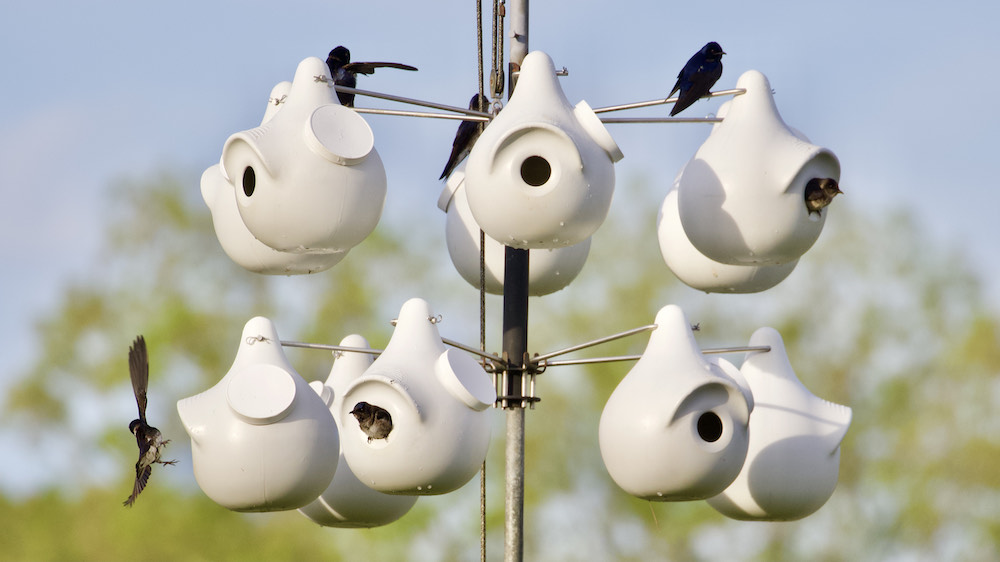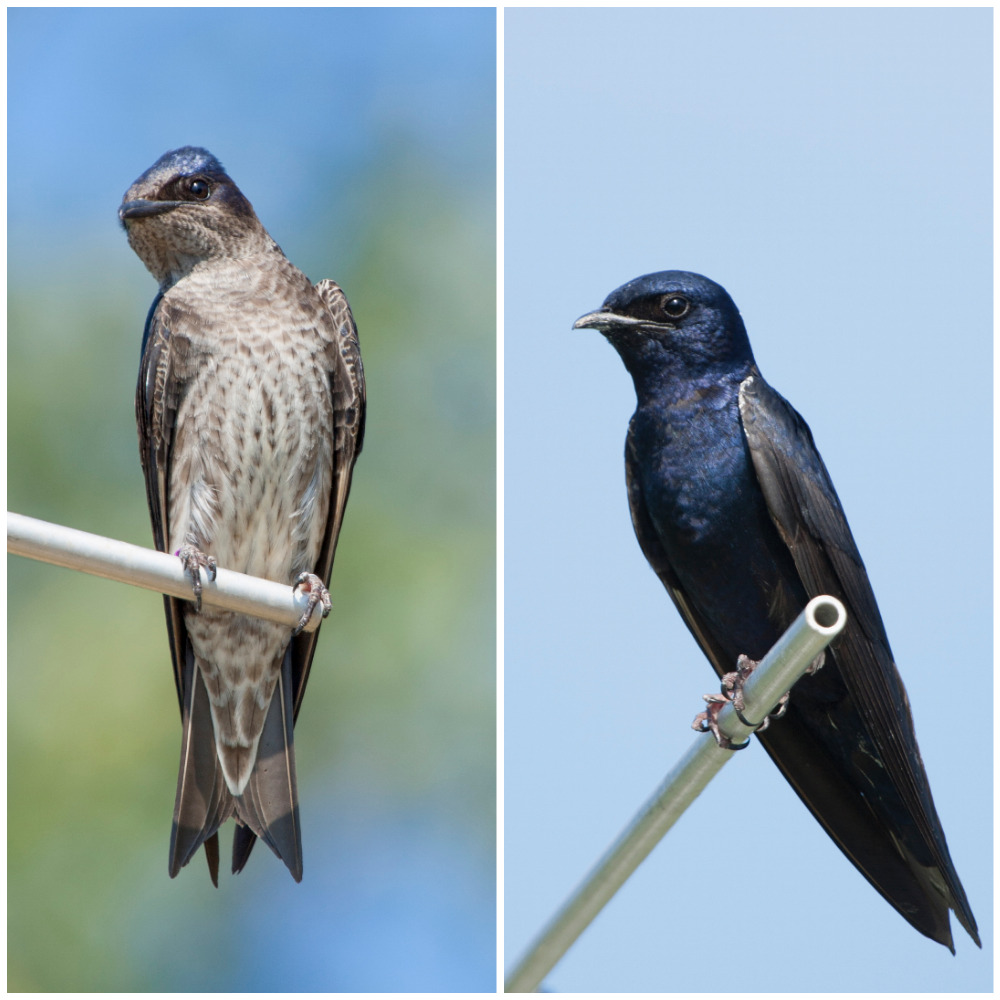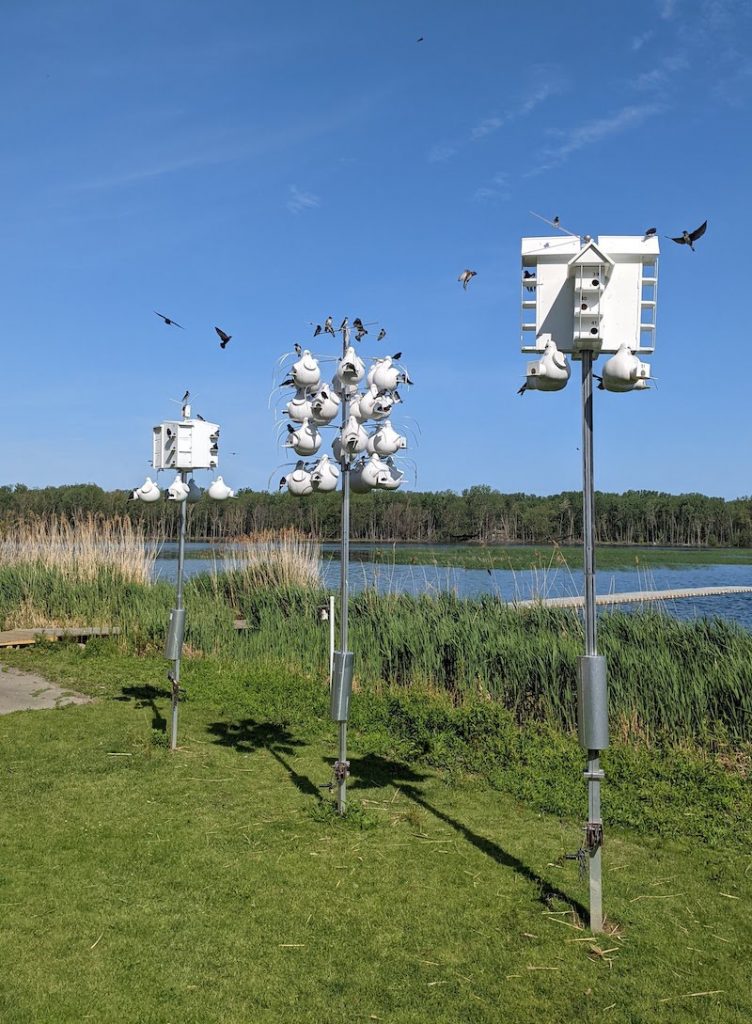
An adult pair of purple martins. The species is almost completely reliant on human-made housing while it resides in North America. Photo courtesy of Purple Martin Conservation Association
On a warm and sunny spring afternoon, the Kyker Bottoms Refuge outside of Knoxville, Tennessee, is alive with the calls and chirps of a purple martin colony as the birds feed, mate and raise their young.
Bird enthusiasts up and down the East Coast eagerly await the period from early to late spring, when purple martins arrive back home after spending the winter in the southern tropics.
The martins, named after the iridescent purple color of the adult male’s feathers, migrate several thousand miles back and forth from North to South America every year. Despite only weighing between 1.6 to 2.1 ounces and measuring about 7.5 inches long, the birds travel an average of 200 miles per day.
Unconventional Housing
When they arrive back on the East Coast, martins return to the same colonies year after year. But unlike most birds, these swallows don’t return to natural nests in trees; they live almost exclusively in human-made housing. These homes are traditionally made of hollowed-out gourds hung from poles.

Purple martin housing at the Kyker Bottoms Refuge near Knoxville, Tennessee. Photo by Harumi Tsuruoka
Before their reliance on humans for housing, purple martins lived in cavities in trees formed from woodpeckers or rock ledges.
The behavioral shift from living in natural cavities to human-made housing is rooted in Native American history. Tribes including the Choctaw and Chickasaw hung gourds on top of poles for purple martins to live in near their villages. This worked in both the people’s and the birds’ favors, as the birds provided Native Americans with insect control, while the proximity to Native American villages provided the martins with protection from predators such as owls and snakes.
The North American arrival of two European bird species, English house sparrows and European starlings, accelerated the martins’ transition to human-made housing. The invasive birds arrived in New York in 1851 and 1890, respectively, and these two aggressive species took over colonies when purple martins migrated south every year. The sparrows and starlings attacked the martins when they arrived back the following years.
Courtney Rousseau, president of the North Carolina Purple Martin Society, a nonprofit organization created for the preservation of purple martins, said that Indigenous peoples were the ones to encourage martins to start relying on man-made housing.“We should definitely give [Native Americans] the credit for encouraging the species and bringing this species to our attention to begin with,” she says.
When Europeans colonized North America, they adopted the same practice, which has continued into the present day.
Though the purple martin is not endangered and is common in the Southeast, their population has decreased by almost 40% since 1966. With each passing year, building purple martin homes becomes increasingly necessary for this unique species’ survival.
Some people, such as landscaper Tom Brake in Abingdon, Virginia, have found alternative housing methods for purple martins.
After starting his purple martin colony in 1996 and building it up to about 70 nesting pairs of birds, Brake found that those population numbers were decreasing. He discovered that owls were getting into his gourds and redesigned his homes, eventually creating a product called ChirpyNest that he has sold now for several years.
In addition to the slanted design of the homes to help protect the martins from owls, the houses have built-in ventilation systems and nests raised above the floor to prevent stagnant air and wet nests.

A female purple martin, left, and a male, right. Photos courtesy of Purple Martin Conservation Association
“Each person develops a passion for them for different reasons, but I love the music,” says Brake. “They sing, I call it music. There’s just a lot of activity around a purple martin colony. It’s invigorating.”
Though there are purple martins found on the West Coast and in southern Canada, the majority of the birds are located in the Eastern United States during the summer breeding months. At the end of their breeding season, the martins will migrate from the United States and spread out across 11 South American countries, ranging from Colombia and Venezuela in the north to Argentina in the south. Brazil is the birds’ primary destination.
Until 2007, the only way to track purple martin migration patterns was through leg banding, which only showed scientists the birds’ final destinations in North and South America. However, this changed when the Purple Martin Conservation Association, a nonprofit organization and leader in purple martin research and conservation, began using geolocators, which track exact migratory patterns and provide much more in-depth information about these birds’ habits, including speed of travel, specific habitat selections and activity levels.

Become a part of the Appalachian Voices’ network of advocates — sign up for action alerts and the our monthly e-newsletter The Advocate today!
Martins at Risk
Purple Martin Conservation Association President Joe Siegrist stated that the geolocators have also provided insight into climate change-related factors contributing to the species’ population loss. In Brazil, where purple martins spend much of their time, hydroelectric dams in the Amazon River have flooded out many of the birds’ preferred habitats. Additionally, increased pesticide use in both Brazil and North America have led to declines in insect populations and a lack of available food for the purple martins as a result.
Illegal gold mining in Brazil has led to mercury pollution entering waterways. While this was previously known, Siegrist said the extent of biologically significant mercury levels making its way up the food chain to purple martins was recently discovered by examining their feathers. Mercury toxicity impacts the martins’ migration back north.
“They’ve done their best to fatten up for the migration while they’re down there,” says Siegrist. “But mercury toxicity impacts their body conditions. So if they’re sick because of mercury toxicity, then they may not make it across the Gulf. That’s a long flight for a little bird the size of your hand.”
Siegrist states that the birds’ migration north only takes a week or two, but the trip south is much more relaxed. The birds only want to go farther south than the cold weather, refueling at a leisurely pace and hanging out in the Amazon for months on end.
“Martins east of the Mississippi River are almost completely dependent on man,” says Courtney Rousseau with the N.C. Purple Martin Society. “And without us, they would be gone. And they’re a charismatic species. They’re fun to watch and fun to study. They’re tolerant of human interaction and intervention and they’re just a wonderful, joy-bringing species. There’s no other species like them here.”
Purple Martin Fun Facts
- Purple Martins feed higher up in the air than most swallows, between 150 feet and 500 feet above ground.
- Martins typically migrate over the Gulf of Mexico without stopping, covering a distance of 500 to 600 miles with no breaks.
- These birds are almost 100% dependent on human-made housing in Eastern North America.
- Human-made housing for purple martins is rooted in Native American culture. Some tribes hung hollow gourds at the tops of poles for the martins to live in.
- Martins feed their young a mix of glass, metal, sand and ground-up eggshells to help them digest insect exoskeletons.
Related Articles
Latest News

Leave a comment
Your email address will not be published. Required fields are marked *
14 responses to “Purple Martins: The Neighbors We Didn’t Know We Wanted”
-
How far above the ground should the house be?
-
Send info
-
I have been a landlord for 40 years. They seem to prefer the natural gourds over the plastic ones when trying to start a new colony.once they are established I then transfer over to plastic and the chirpy nest houses. I have three colonies and encourage friends to get established also.
-
We have been attracting purple martins for the past eighteen years. Starting with a six room metal box to multiple houses and gourds with a colony of forty pairs. This year 2022 June and July have taken an unprecedented toll on fledgling’s do to the heat. Looking for a way to shade metal housing, the gourds seem to be less affected by the heat. Thinking of doing away with the metal houses and just putting up the gourds.
-
We have a plastic purple Martin house with 12 holes. 6 on each side. The thing started to lean badly and we were going to take it down the pokecid in concrete so we never got around to it and never had birds .
This year for the first time we were amazed to see them going in and out. My husband thought I was losing it. What wonderful enjoyment watching them. I want another house now. We have over our river wall with people around and it never bothers them. -
Remember theae are wild bird! I had a few that continued to make a home in my mailbox for 5 years. They are beautiful. Except for the poop,I didn’t mind it. This year was a very different story.They became mean.I could not leave my home without being attacked. All people walking or biking nearby were attacked. Mowing grass, getting in and out of car, and receiving guests required umbrellas and bike helmets.Their nesting days at my home are over.
-
People keep increasing their gourds every year which causes 2 problems. #1 It keeps other purple martin want to be landlords from getting started.
#2 A large colony will cause the martins to compete for food in one area possibly causing starvation. -
I want to try and start a purple Martin colony but when I read they eat butterfly’s and dragon floyd I’m not sure now.I am also trying to attract monarchs.
-
Should I put a purple Martin house over open water
-
Try the “Morning Dawn Song & Daytime Chatter” CD in the mornings and afternoons. Try some Decoys as well and see what happens.
-
I attracted Purple Martins by placing a CD player at the base of the bird house and playing CD of purple Martin songs and by placing plastic decoys on the birdhouse. Both are available on line. I had purple martins with in a couple of days. Good luck. Very much worth the effort.
-
I have had over 15 generations of Martins a my home on the Delaware shore. They arrived back in the first week of April. I have three large metal house that fill to the brim and several gourds.
-
I’ve been trying to attract the purple Martin to my backyard for years.
Any help is appreciated. -
I’ve had Purple Martin’s for more than 60 years since I was 9 years old. I’m 71 years old now. My elementary school years I lived in North Little Rock Arkansas on the CAMP ROBINSON MILITARY BASE where I first became interested in Purple Martins. My Dad was a Fireman there where a few Purple Martin houses were around the Fire Station. The Captain Bob McDaniels lived in part of the Fire Station with his family. A Bird enthusiast lady, Mrs Glass we all called ” The Bird Lady ” built and hundreds of wooden houses for Purple Martin’s and Blue Birds. The Post’s Swimming Pool was across the street from my Dad’s Fire Station where I spent some hot summer days watching the Martin’s flying around with their friendly chatter. It’s there where I first fell in love with the Purple Martin and I’ve been hooked for life. I now have a very large colony with a little over one hundred poles with aluminum multi compartments houses on each pole. I think there are around 1,300 compartments 6″×12″×6″. I don’t do nest checks but I know I’ve had a few hundred Martin’s total a few years ago, but fewer numbers the last few years. Hawks and snakes take a major toll wiping out about half of my colony each year leaving me extremely mad and frustrated. During Martin’s nesting season I keep a few laying hens and leave the eggs for the snakes in hopes the snakes will eat the chicken eggs and not eat my Martin’s or their eggs or adults or young birds. Snakes will eat the entire contents of every egg and Bird in the house. I have had snakes stay up in the houses for days straight. I believe they engorged their body and could not get out of the 2″ hole.
Today is March the 10th and I have not seen my first Bird yet. They are usually here in the first week of March and often the last week of February.When people tell me they have had a Purple Martin House up for years and have never had a Bird yet.
I tell them they need to put up a minimum of ” 5 houses ” about 60 feet from trees or a building in a n open area yet close to your patio or drive way where you are most active. Purple Martin’s feel safer near people and not 200 yards away in an open field by the pond. Martin’s love to be with people.If your house has the standard 6″×6″×6″ rooms take out a wall to enlarge every to a double size 6″×6″×12″ and glue in a plug of black hard plastic to block one of the holes and to add about 1/2 inch of pine straw to help start the nest.
Remember (5) house minimum
Dennie Mahan
Damascus, Arkansas






Leave a Comment